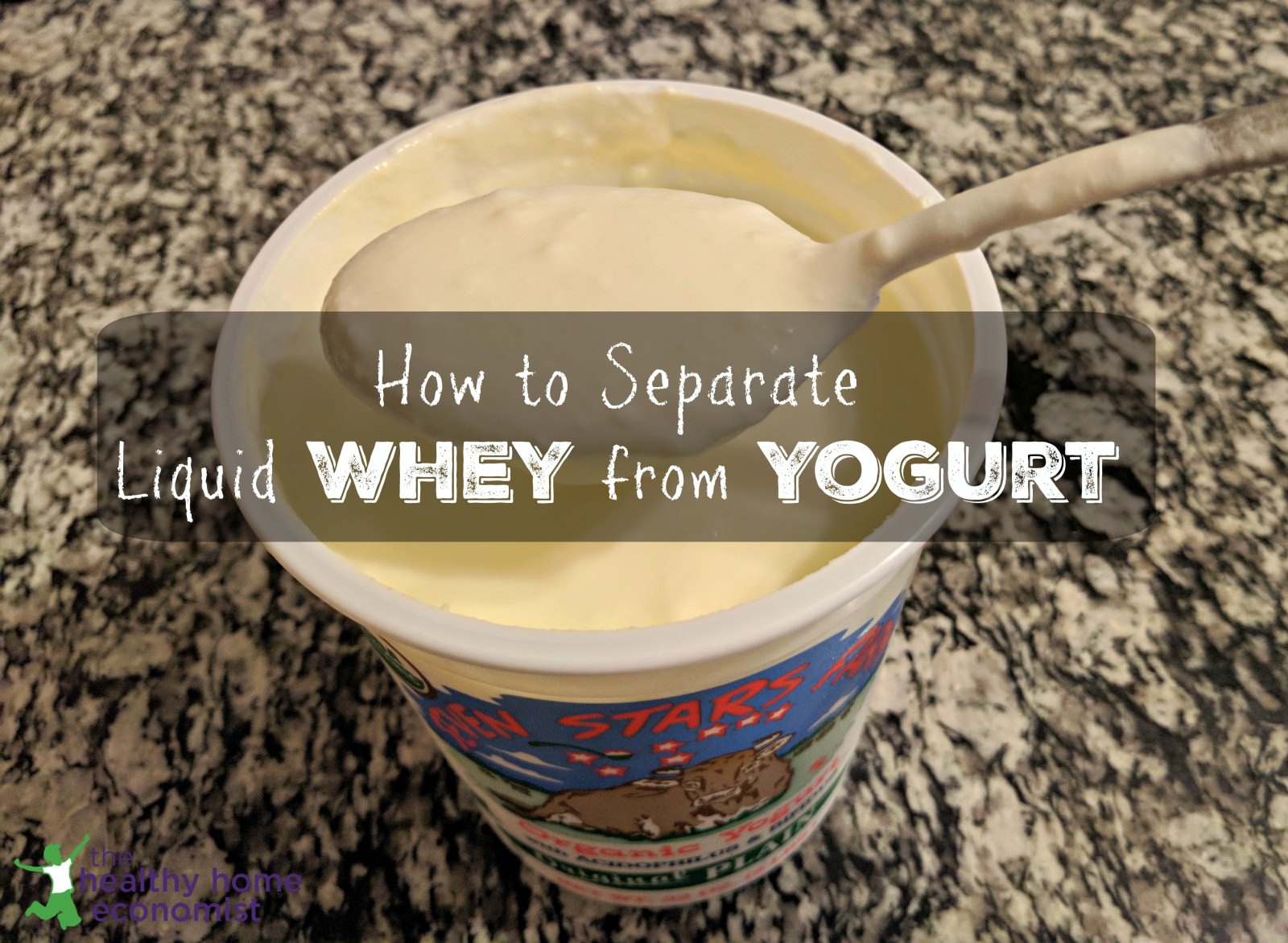Table of Contents[Hide][Show]
 Whey in its liquid and whole food form is the ideal starter for probiotic-rich, health-enhancing fermented foods and drinks.
Whey in its liquid and whole food form is the ideal starter for probiotic-rich, health-enhancing fermented foods and drinks.
Liquid whey is most easily and economically obtained from soured raw milk also called clabbered milk.
Clabbered milk is a very useful item for the traditionally minded cook and has the consistency and taste of drinkable style yogurt.
Unfortunately, not everyone has access to raw milk which may seem to preclude the use of unprocessed, liquid whey for fermentation purposes as it is not commercially available.
The good news is that you can easily extract whey from plain yogurt from the store. Using homemade yogurt is even better. You may use Greek yogurt too although you won’t get as much whey from the effort. This is due to the nutritional differences of Greek yogurt vs regular yogurt.
Powdered Whey No Substitute for the Real Thing
Please note that powdered whey is never an adequate substitute for whole, unprocessed, liquid whey. To gain the benefits of whey, it must be gently separated from a fermented dairy product like clabbered milk, kefir, or yogurt.
Drying and powderizing whey even at low temperatures denature the delicate proteins. It also eliminates the beneficial probiotic and enzymatic properties.
Uses for Liquid Whey
Liquid whey is an important ingredient in homemade baby formula recipes. In addition, it is indispensable as an inoculant for fermented foods and drinks. Unprocessed liquid whey is also wonderful to mix with filtered water and a little orange juice for a healthy sports drink naturally loaded with electrolytes.
How to Separate Whey from Yogurt (or Kefir)
The easy recipe below will result in a jar of beautiful raw whey within minutes! You won’t believe how easy it is! I recommend that you do not use Greek yogurt, as it contains significantly less whey than regular yogurt.
I also recommend that you stick with quality yogurt brands as there is quite a bit of variation within the industry.

How to Separate Whey from Yogurt
Simple how-to for separating whey from yogurt or kefir. Homemade or store bought brands may be used including whole, lowfat, and no fat versions. Whole yogurt is recommended, however.
Ingredients
- 1 quart plain yogurt kefir may be substituted
- 1 large glass bowl
- 1 fine mesh cheese cloth
- 1 large rubber band
Instructions
-
Line bowl with cheesecloth. Spoon in the container of yogurt.
-
Gather up the ends of the cheesecloth and secure with the rubber band. Attach the rubber band to a knob on one of your upper kitchen cabinets. Keep the bowl beneath to catch the dripping whey.
-
Leave dripping on the counter for about 1 hour.
-
Remove drip bag from the kitchen knob and place in a clean bowl. Unfasten the rubber band and scrape out the yogurt cheese within the cheesecloth into a container. Seal the lid and refrigerate.
-
Pour the liquid whey in the first bowl into a glass mason jar and secure the lid. Refrigerate. It will stay fresh for several months.
Separating Whey from Yogurt (Video Tutorial)
In the video below, I show you the very easy process for obtaining whey in its liquid, whole food form from a quart of plain yogurt. I also discuss what to do with the leftover yogurt cheese once the whey has been extracted. Hint: it makes a delicious stuffing for large pasta shells or lasagna.
Note that you can use kefir in place of yogurt if desired. Use the exact same process shown in the video. Kefir is healthier than yogurt too, containing far more beneficial probiotics. Unfortunately, it is harder to find quality brands commercially, but fortunately, kefir is easier to make at home than yogurt if that’s what you’d really prefer to use.
If using yogurt, you are going to want to source the best quality your budget can afford. Ideally, this is grass-fed organic whole yogurt. But, in a pinch, you can use no fat or low-fat yogurt from supermarket brands like Dannon.
Cloudy or clear liquid whey will last in a glass mason jar in the refrigerator for about six months. Note, however, that the flavor will grow stronger and more pungent over time.








OK, thank you. I will try making the kefir at home. I watched your video on that and it was great. It seems relatively easy! If I’m going to be making baby formula in the future, I want to be able to make whey without have to make it every couple of days (and having a lot of yogurt cheese leftover.) Thanks again!
Hi Sarah, If I make liquid whey from homemade or store-bought kefir, will I get more whey than I would from store-bought yogurt? Thanks!
Homemade kefir will definitely give you more whey, but not necessarily store bought as it seems to me they drain it off before packaging.
Good morning! I use liquid whey to make baby formula. The recipe I follow says to leave the whey out overnight and in the morning to put it into the refrigerator in a glass mason jar. I forgot the next morning to put the whey into the refrigerator and it sat out overnight and a good portion of the next day. Do I need to throw it away? Or do you think it is still ok to use? Thank you for your help!
The whey is fine, but it may be too strong tasting to use for the formula. Taste it and see. It depends how warm your kitchen was.
Please offer some alternatives to whey for those with real milk allergies.
Sauerkraut juice from properly fermented sauerkraut is the only viable substitute I am aware of.
Is there any good substitute for whey? We are looking for a truly dairy-free formula for a highly allergic 7-week old with a strong family history of dairy allergies.
Just leave the liquid whey out of this nondairy formula if necessary. https://www.thehealthyhomeeconomist.com/video-hypoallergenic-baby-formula/
I can’t seem to find any information on whether the yogurt or kefir needs to be cold or room temperature when I put it in the cheesecloth?
Twice I have bought cheese cloth at Walmart. Both times the yogurt went right through the cloth into the bowl- the wholes were to large. Do I need to fold it or is there a particular kind I should use. Have beets and cucumbers waiting for whey to ferment. Thanks!
You need cheesecloth with tiny holes. Or, just use a flour sack cloth.
Where do you get your info about whey protein powder being denatured? This is 2016, unless you’ve been living under a rug everyone knows that whey protein is the most bioavailable form of protein based on the four protein rating systems(PER,BV,NPU,PDCACS), followed in second by whole eggs. To say that we don’t absorb the protein from powdered whey proteins is doing your readers a disservice. It’s an easy and time efficient way to get a good amount of quality protein. If you feel tha the four protein rating systems are somehow flawed and not accurate then I would like to hear about it but the science is clear on the subject.
Whey protein is wonderful when it is whole and in its natural state but not when it’s been denatured via processing and powderization. Then it is a factory food that should be avoided. Why do people become so attached to processed foods marketed as “healthy”? Usually because they are convenient. Actually, I’ve not been living under a rug and am keeping up on all the marketing hype with these nasty protein powders and noting how many people seem to develop health issues with them when used for long periods of time.
Can I use the cream leftover from yogurt or raw milk as a substitute for mayonnaise? I have a diabetic recipe for cole slaw and it uses the cream from plain yogurt and tastes great.
Yes you can … it is raw cream cheese (if from clabbered milk) or yogurt cheese (if from yogurt). I use to to make cheese cake, cream cheese spread for bagels and numerous other uses.
Here’s an article on yogurt cheese: https://www.thehealthyhomeeconomist.com/how-to-make-yogurt-cheese-raw-or-heated/
Hi Sarah
Iv been making homemade formula for my son for the past four months or so and have been getting whey from Store bought plain yogurt. Once or twice now I have forgotten about it on the counter and it sat for a day or two. Can it go bad? And if so how quickly? Usually it comes out pretty transparent yellowish color but the last batch I made set out for two days and it’s a little cloudy and it looks like there’s a chunk or two floating in it. I’m guessing it’s gone bad although it smells normal compared to the other batches iv made. What do u think? And how quickly should I get it in the fridge after leaving it out over night to get the whey out? Also do you happen to know any side effects it might have on my son if the way has gone sour and I have added it to his formula? I appreciate your time and all the videos you have posted thanx again!